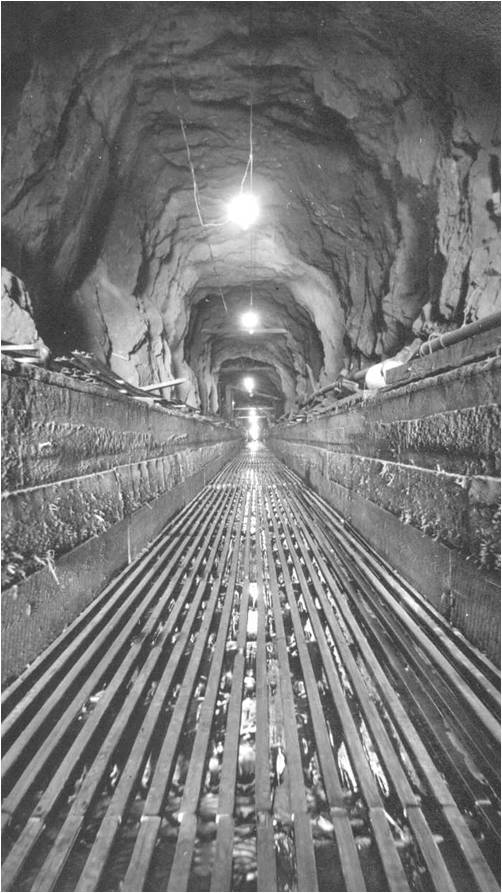Mining Display

Gold was discovered on the Fraser River in the spring of 1857 and by 1859 prospectors had reached the Quesnel river.
The area quickly flooded with gold seekers hoping to strike it rich placer mining, looking for loose gold deposited in gravel, sand or soil.
This map shows claims staked in the area between 1859 and 1897. From its inception the town of Quesnel was a multicultural community, as the names of many of the claims seen here suggest.

In an effort to solidify British claims on the region and prevent American annexation, Governor James Douglas implemented a system of Free Miner’s certificates in 1858. These certificates are still required by prospectors today. This certificate, housed in our archives, was issued in 1914.

Placer miners use water to separate gravel, soil and other debris from gold which is much heavier. Large operations required vast amounts of water to operate. They used flumes like the one pictured here to redirect creeks to their workings.

Hydraulic monitors used water to wash away hillsides to gain access to gold bearing gravel. The drastic environmental impact of this practice led to it being banned in 1972. An intake box and nozzle can be seen within our display and hydraulic monitors are displayed in the cages outside the building.

 Other miners, like these men on the Sheepshead claim, would work long shifts underground digging out ore bearing gravel from deep underground. The gravel was then taken to the surface in ore buckets such as the one displayed here.
Other miners, like these men on the Sheepshead claim, would work long shifts underground digging out ore bearing gravel from deep underground. The gravel was then taken to the surface in ore buckets such as the one displayed here.

Water could also cause problems for the miners, flooding their underground workings. Cornish waterwheels such as the one seen here were used to pump water out of mine shafts. A waterwheel like this was moved from Barkerville to Quesnel’s Front Street in 1930 and can be seen there today.

 Smaller operations relied on hard work and ingenuity. Constructed from jam cans, this waterwheel was used at Woodpecker. These tools, repurposed from a file and a steel cable, were used to clean gold from crevices. They were found on Bill Hong’s claim at Slough Creek.
Smaller operations relied on hard work and ingenuity. Constructed from jam cans, this waterwheel was used at Woodpecker. These tools, repurposed from a file and a steel cable, were used to clean gold from crevices. They were found on Bill Hong’s claim at Slough Creek.

The population of the Cariboo dropped as many of the deposits of placer gold played out and as prospectors set out to new strikes made elsewhere in the province. Some operations carried on through this period such as the Kafue Coy Mine at Antler Creek. This 1923 photograph shows Tommy Harmon and Ralph Roddick hauling equipment from Quesnel to the mine.

Our region’s second gold rush began in the 1930s. Prospecting, which offered individuals a living wage (a rare commodity during the Great Depression), once again became popular. This claim notice (housed in our archives) was issued to Mrs. Nellie Baker, wife of Dr. Baker, in 1934.

Prospecting offered the dream of a big payout for a small investment. This picture, taken in the spring of 1933, shows Ivor MacGregor with an entire prospecting outfit in a homemade boat. Note the hindquarter of a moose at the front of the canoe.

A dredge and crane working in a tailings pond, Wells BC. Dredges were enormous floating placer mining machines which were used in the first half of the twentieth century.

Labour, freight, and equipment costs made mining on a large scale very expensive. This prospectus was published by one of the companies attempting to entice investors and raise the capital needed to develop properties in the Wells area during the 1930s.
As mining technology advanced the era of lode (or hard rock) mining in the Cariboo began. Lode mining involves extracting large amounts of ore, crushing it and extracting the gold. Two major hard rock operations began operating in Wells during the Great Depression. Fred Wells’ Cariboo Gold Quartz Mine began production in 1933, and the Island Mountain Mine began development the same year. This period is generally considered our second gold rush.
A detailed description of the lode mining process can be found on the Wells Museum’s website at http://wells.entirety.ca/mining.html

Hard rock miners at the Cariboo Gold Quartz Mine shaft entrance in Wells, B.C. This company operated in Wells until 1967.



Underground workings at the Bullion Mine operations, note the electric lights strung above.
Lighting was a challenge in the dark and damp underground workings. Early miners relied on candles and candle holders known as ‘sticking toms’ such as the one seen here. Later miners used carbide or kerosene lamps and finally electric lights.

Pouring a gold brick at the Cariboo Gold Quartz mine, 1935. A gold brick mold used by this mine can be seen in our display.

Bill Hong at the Slough Creek gold claim. Bill generously donated many of the mining artifacts and Chinese cultural artifacts in our collection. For more information about mining in the Cariboo look for Bill’s book, And So That’s How It Happened. Available in our gift shop, it recounts 75 years of life in the mining towns of Barkerville and Stanley.